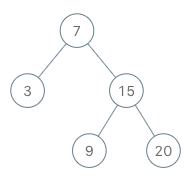Binary Search Tree Iterator (M)
题目
Implement an iterator over a binary search tree (BST). Your iterator will be initialized with the root node of a BST.
Calling next() will return the next smallest number in the BST.
Example:

BSTIterator iterator = new BSTIterator(root);
iterator.next(); // return 3
iterator.next(); // return 7
iterator.hasNext(); // return true
iterator.next(); // return 9
iterator.hasNext(); // return true
iterator.next(); // return 15
iterator.hasNext(); // return true
iterator.next(); // return 20
iterator.hasNext(); // return false
Note:
next()andhasNext()should run in average O(1) time and uses O(h) memory, where h is the height of the tree.- You may assume that
next()call will always be valid, that is, there will be at least a next smallest number in the BST whennext()is called.
题意
实现一个BST迭代器,要求next()和hasNext()的平均时间复杂度为(O(1))且空间复杂度为(O(h))。
思路
如果没有复杂度限制,那么最简单的方法就是先一遍中序遍历将所有值记录下来,调用next()时挨个返回就行。空间复杂度为(O(h)),做法就参考中序遍历的迭代实现:初始化时先将最左侧的边存储下来,每次调用next()时,栈顶元素就是下一个应返回的结点,出栈后将该结点右子树的最左侧边存入栈。重复上述过程,栈中元素数量最大为树高,且查询平均复杂度为(O(1))。
代码实现
Java
class BSTIterator {
private Deque<TreeNode> stack;
private int index;
public BSTIterator(TreeNode root) {
stack = new ArrayDeque<>();
while (root != null) {
stack.push(root);
root = root.left;
}
}
/**
* @return the next smallest number
*/
public int next() {
TreeNode node = stack.pop();
TreeNode tmp = node.right;
while (tmp != null) {
stack.push(tmp);
tmp = tmp.left;
}
return node.val;
}
/**
* @return whether we have a next smallest number
*/
public boolean hasNext() {
return !stack.isEmpty();
}
}
JavaScript
/**
* Definition for a binary tree node.
* function TreeNode(val, left, right) {
* this.val = (val===undefined ? 0 : val)
* this.left = (left===undefined ? null : left)
* this.right = (right===undefined ? null : right)
* }
*/
/**
* @param {TreeNode} root
*/
var BSTIterator = function (root) {
this.stack = []
while (root) {
this.stack.push(root)
root = root.left
}
}
/**
* @return {number}
*/
BSTIterator.prototype.next = function () {
let top = this.stack.pop()
let p = top.right
while (p) {
this.stack.push(p)
p = p.left
}
return top.val
}
/**
* @return {boolean}
*/
BSTIterator.prototype.hasNext = function () {
return this.stack.length
}